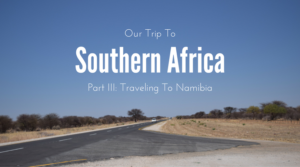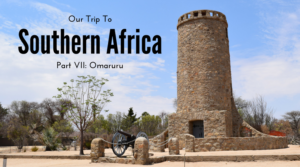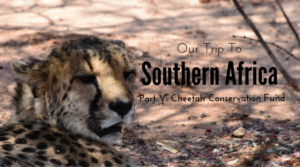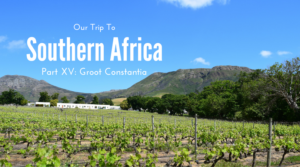The tour around the Cape Peninsula with Carlos had so far included seals, penguins and a few glasses of wine. The wine glass would remain empty the rest of the day, but there were going to be more sights of animals. The Cape Point itself had a few close encounters to offer as well as an amazing view.


Cape of Good Hope Nature Reserve
Cape of Good Hope Nature Reserve is a part of the Table Mountain National Park and it incorporates both Cape Point as well as the Cape of Good Hope. The reserve lies on the southernmost tip of the Cape Peninsula and offers both amazing views as well as the possibility to spot several animal and bird species.
We arrived at the Cape of Good Hope Nature Reserve after a short drive from our encounter with the penguins at Boulders Bay. At the entrance to the Nature Reserve, there was a fee of 135 rands per person. After paying we were on our way to the Cape of Good Hope.
Cape of Good Hope
The Cape of Good Hope was for a long time thought to be the southern-most tip of Africa and by that the meeting point of the Atlantic and Indian Oceans. We would have to wait until the next day before we had the possibility to stand at the southernmost point of Africa in Cape Agulhas, but visiting the famous Cape of Good Hope was spectacular nonetheless.
We only had a short stop at the Cape of Good Hope. It is a nice sight, but we did not have enough time for hiking in the area to really appreciate it. At the cape, there was a sign stating the coordinates as well as a view out over the oceans. It was a place where it would have been possible to sit for hours just enjoying the scenery.
We were not the only ones enjoying the tranquility, apart from all the other tourists there were also a few ostriches walking around in the area.





Chacma Baboons
From the Cape of Good Hope we continued the few kilometers to the Cape Point. Here Carlos dropped us of so that we could explore the area by ourselves for some time. We decided to actually walk up to the Cape Point instead of taking the funicular that was the other option. That is a decision we do not regret. There are signs all over the area telling people not to feed the baboons, but we had so far not been lucky enough as to see them. Now, when walking up the hill we saw one of them running down the path continuing past us. Further up we spotted the rest of the troop slowly following him.
Susann was not that fond of sharing the small path with the baboons, but luckily they didn’t cause us any problems. We had heard enough stories about baboons stealing everything from food to camera equipment to keep most of that stuff out of their sight.
Continuing upward we passed by the baboon family and had the possibility to see the kids playing in the branches under the supervision of a female. It is the Chacma Baboon that is present in the area, also known as the Cape Baboon.








Cape Point
We soon arrived at the top of the hill. It is here that the lighthouse from 1859 stands, guarding the oceans. This is a place where you just have to enjoy the view for some time. It is hard to imagine that when looking south, somewhere far out there is Antarctica. There are no obstacles in the way to reaching the southern continent except the ocean itself. It is a mighty feeling that overcomes you when overlooking the oceans from the cape.
After spending some time for photos and admiring the view we slowly started to descend back to the car park. It was not a long walk, but it takes some time when a few times to have a last look at the edge of Africa.
Back down we started to queue for a small pizza, just to get that small snack to survive the rest of the afternoon before we were back and could get some dinner. We had declined Carlos’s suggestion to stop at one restaurant to make sure that we would be back in the city before Table Mountain was going to close for the day.





Join Us in Exploring Southern Africa
Here are all the posts belonging to the series about our trip to South Africa and Namibia. Read the parts by clicking on the links below:
- Part I: Doha, Qatar
- Part II: Johannesburg, South Africa
- Part III: Traveling To Namibia
- Part IV: Otjiwarongo, Namibia
- Part V: Cheetah Conservation Fund, Namibia
- Part VI: Etosha National Park, Namibia
- Part VII: Omaruru, Namibia
- Part VIII: Okahandja, Namibia
- Part IX: Windhoek, Namibia
- Part X: Cape Town, South Africa
- Part XI: Castle of Good Hope, South Africa
- Part XII: Kirstenbosch Botanical Garden, South Africa
- Part XIII: Two Oceans Aquarium, South Africa
- Part XIV: Mariner’s Wharf, South Africa
- Part XV: Groot Constantia, South Africa
- Part XVI: Boulders Beach, South Africa
- Part XVII: Cape Point, South Africa
- Part XVIII: Chapman’s Peak Drive, South Africa
- Part XIX: Table Mountain, South Africa
- Part XX: Swellendam, South Africa
- Part XXI: Plettenberg Bay, South Africa
- Part XXII: Birds of Eden, South Africa
- Part XXIII: Port Elizabeth, South Africa
- Part XXIV: Good Bye Africa!
- Part XXV: Trip Summary
Join us as we explore Southern Africa






